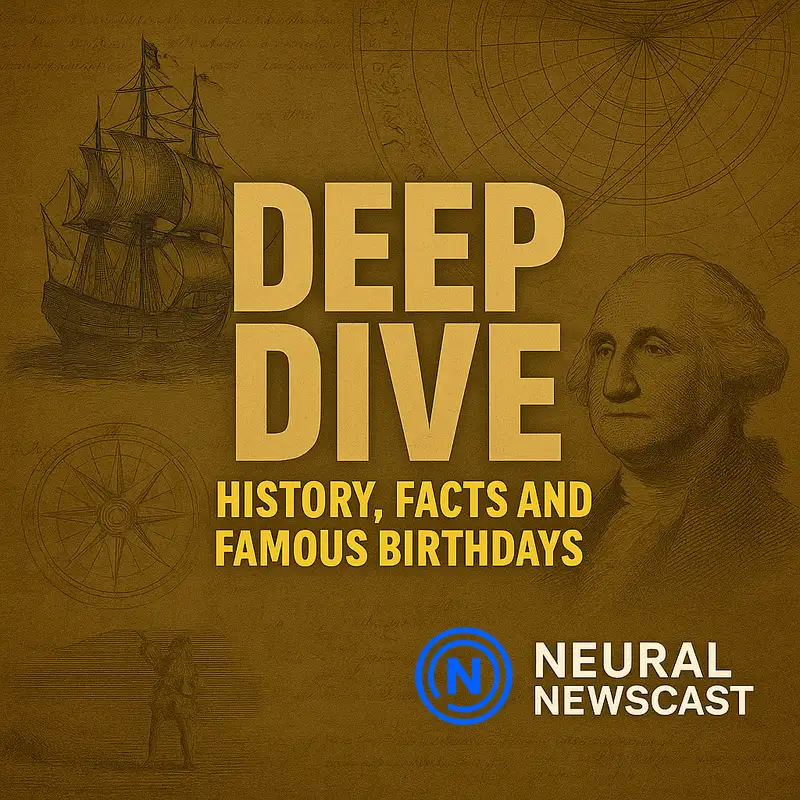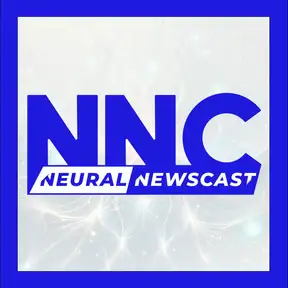Deep Dive: Patents, Patronage, and Processing Speed: Steamboats, Guggenheim, and the Brain - August 26, 2025
From AI-generated insights to human-reviewed accuracy, this is Neural Newscast, keeping you informed every day.
Welcome to Neural Newscast's deep dive.
I'm Kara, your technology reporter, and with me is Ethan, your economy correspondent.
Today we're exploring some fascinating topics.
On this day in 1791, rival inventors John Fitch and James Rumsey each received a federal patent for the steamboat,
settling a fierce dispute over who invented the steam-powered vessel.
That single sentence carries a lot.
Two rival inventors, a patent resolution, and the steamboat as the contested invention.
It's compact but loaded with economic and technological implications.
Exactly. Two patents issued at once implies the government stepped in to resolve leadership
and a key innovation, and from a tech perspective that recognition must have changed incentives
for steam navigation development.
From the market angle, patents like these can clear uncertainty, letting capital flow
toward commercialization. Knowing who held legal rights to steam-powered vessels would
affect investors' willingness to fund production and infrastructure.
And it reframes how we think about invention, not always a solo flash of genius, but often
parallel efforts that a patent system has to adjudicate.
Two inventors, Fitch and Rumsey, both tied to the same breakthrough.
That dispute being settled by federal patents also signals the early republic's role in
establishing intellectual property norms, which matter for nascent industries where first-mover
advantages are huge.
The steamboat itself transformed transport and resolving who owned the invention could accelerate practical engineering work.
Standardizing designs, optimizing boilers and paddle systems, that sort of thing.
Economically, faster river transport would lower trade costs, expand markets inland, and shift regional trade patterns.
Ownership clarity helps merchants and banks plan for that shift.
It's interesting to consider the narrative.
Two figures locked in a fierce dispute, and then the government essentially saying both
had claims significant enough to be formalized adds texture to the story of technological
progress.
And the word fierce hints at litigation or competition that could have deterred investment,
so the patents likely reduce that friction, enabling entrepreneurs to build on steam power
with a clearer legal backdrop.
For engineers and inventors following them, that kind of resolution probably signaled that the state was an arbiter worth engaging with.
Patents could confirm not just profits, but legitimacy.
Right, legitimacy that turns technological possibility into economic reality.
Merchant capital, shipyards, and insurers respond differently when rights are delineated.
So that compact historical note, Fitch and Rumsey receiving federal patents in 1791,
captures a pivotal moment where invention, law, and commerce intersected around the steamboat.
And it's a reminder that behind transformative technologies, there are often contested claims and institutional decisions that shape who benefits and how quickly the technology spreads.
Time for a quick pause. We'll explore more when Neural Newscast Deep Dive returns.
Today we celebrate the birthdays of Peggy Guggenheim, 1898, Christopher Isherwood, 1904, and Albert Sabin, 1906.
Focusing in, Peggy Guggenheim feels like the one whose choices ripple into both culture and markets.
An art collector and patron who really shifted the economics of the modern art world.
Absolutely. She wasn't just buying works, she was creating platforms.
London's Guggenheim Gin and New York's Art of the Century were more like labs for avant-garde practice than traditional galleries.
That strategic positioning mattered economically.
By backing emerging talents like Jackson Pollock, she helped convert speculative interest into lasting market value, which in turn reshaped collector's behavior.
And there's the wartime angle that fascinates me.
She actively supported artists during turbulent years, offering both financial and curatorial
lifelines that allowed new movements to survive and evolve.
Right, her wartime support had downstream effects.
Artists who might have been lost were instead able to produce the work that later attracted
institutional collecting and philanthropy, changing cultural capital into tangible assets.
A lesser-known tidbit.
Her galleries weren't just transactional spaces, they were social engines.
Salons, exhibitions, provocations, places where audiences learn to see modern art differently.
That kind of audience education is a form of infrastructure.
And that infrastructure influenced both private collectors and public institutions.
Venice's Peggy Guggenheim Collection is the culmination,
the place where her curatorial risk-taking was institutionalized and made accessible to the world.
It's striking to me how her eye for the avant-garde anticipated broader technological and cultural
shifts, spotting creators on the brink and giving them space to experiment, which is
a playbook we still see today in tech incubators and creative hubs.
From a financial perspective, she modeled how patronage can seed entire markets, early
risk, concentrated curation, and a narrative that elevates value.
the result is cultural legacy and a more robust, diversified art economy.
When we look at our legacy now, it's not just the paintings or the museum.
It's the idea that an individual curator-patron can change the trajectory of a whole movement.
And that risk-taking and supportive ideas pays cultural dividends.
And that resonates beyond art.
The interplay of patronage, market formation, and public institutions she embodied is a blueprint for how innovation gets funded and preserved,
very relevant to how we think about funding breakthroughs today.
Peggy Guggenheim's story is a reminder that courageous curation and sustained support can redirect history
and that the institutions we take for granted often started as someone's bold bet.
Her legacy lives on in the collection, the market she helped shape, and the artists who found their footing because she took that bet, still relevant to how we evaluate and invest in emergent talent.
Time for a quick pause. We'll explore more when Neural Newscast Deep Dive returns.
This is Neural Newscast, where machine learning meets meaningful reporting.
All stories are reviewed for accuracy before release.
Find our full archive at neuralnewscast.com.
Welcome back to Neural Newscast Deep Dive.
Let's continue our exploration.
Thanks for staying with us on Neural Newscast Deep Dive.
Let's get back to our discussion.
The human brain can process information as fast as 120 meters per second.
That's a striking way to put it, Kara.
Using meters per second gives a physical immediacy to neuro-processing.
Exactly.
It frames processing speed in spatial terms, which makes you rethink what fast really means
for cognition.
From a financial perspective, that phrasing highlights how rapidly information can influence
decisions in markets.
And as a tech correspondent, I find the metric useful when comparing biological processing
to electronic systems.
It also underscores why timing matters in markets.
Information moving at that rate can change outcomes almost instantaneously.
The imagery of 120 meters per second makes the brain feel less abstract and more like an engineered network in motion.
Right, it invites questions about latency and advantage.
Who can act on information fastest?
It also reminds listeners that our neural hardware operates with impressive physical constraints.
And that speed translates into real-world consequences from split-second choices to market reactions.
Saying it that way makes the science accessible without losing precision.
Agreed.
120 meters per second is a concise, powerful fact that connects biology to behavior and economics.
That's all for this Neural Newscast deep dive.
On behalf of Kara and myself, Ethan, thanks for listening.
Join the conversation.
Follow Neural Newscast on X, connect with us on Bumble and Facebook,
or visit neuralnewscast.com for all things NNC.
Neural Newscast blends real and AI-generated voices for fast, high-quality production.
All content is AI-generated with human oversight, including fact-checking and review.
While we aim for accuracy and neutrality, errors may occur.
Verify critical details from trusted sources.
Learn more at nnewscast.com.
Creators and Guests




